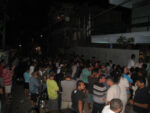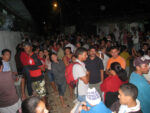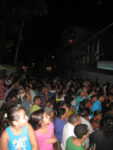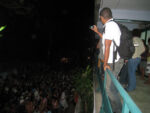After the torrential rains that began on April 6th 2010, and the tragic mudslides which left many dead and thousands more homeless, the Municipal Government of Rio de Janeiro, led by mayor Eduardo Paes, said the city would immediately remove some 4,000 families from eight slums in high-risk areas and provide them with a monthly stipend. The relocations began earlier this week. These high-risk areas have been designated by the Municipal and State government as area of extreme-risk for future mudslides. On April 13th Geo-Rio (Geotechnical Institute in Rio de Janeiro) delivered a report recommending the immediate and complete removal of these following communities: Urubu (Pilares), Prazeres (Rio Comprido), Fogueteiro (Centro), São João Batista (Botafogo), Cantinho do Céu e Pantanal (parte da comunidade do Turano, na Tijuca), Laboriaux (Rocinha) e Parque Columbia (às margens do Rio Acari). All of these areas are considered favelas (urban slums)
There are a few Mundo Real team members living in the Laboriaux area of Rocinha and we have been thoroughly involved in everything taking place there during and since the rains. We have been observing the aggressive manner in which the government has been conducting the removal of these families. The homeless families who have lost their homes and who have no place to go have been placed in makeshift shelters with poor conditions. Dozens of Laboriaux’s residents have expressed to us that they are being treated with disrespect and arrogance by the actions of the Civil Defense and others representing the Municipal Government. The government officials are making their way through the area spray painting houses in very large letters and numbers making clear for all to see that everything will be demolished. They are also appraising homes in complete disregard to the fact that Laboriaux has among the best and most panoramic views of the city of Rio de Janeiro. There are several confusing forms of social assistance the government is offering residents to leave their homes. One of which is a monthly stipend called “social rent”. This “social rent” consists of 400 reais (roughly $170 US dollars) to cover monthly rent while the authorities try to figure out where to relocate the displaced residents on Laboriaux. Currently the government has presented only two eventual housing solutions for Laboriaux’s displaced families – either they will be relocated to Frei Caneca (an old prison complex turned into a housing project) in an post industrial area in the center of the city or to apartments in Jacarepagua, located about an hour away from the city center in Rio’s Westside.
This rapid removal is being done without presenting any real geological evaluation or scientific proof to the community indicating that the entire area is in extreme risk of falling of the mountain. They have been doing this quickly and quietly so as not to allow any mobilization or resistance from the people. Ironically Laboriaux has existed since 1982 when the Municipal Government relocated hundreds of people to the area from another part of Rocinha, known as Valão, which at the time they also deemed an ‘extreme risk’ because of flooding. According to a recent government census, from July of 2009 Laboriaux has over 823 households and during the recent rains only 2 unfortunate fatalities occurred. Many parts of the neighborhood are located on level ground.
In Morro das Prazeres, a community of roughly 12,000, where 30 people were killed during the mudslides, some resistance to complete removal has been mounting and they have demanded that the city treat them with dignity throughout the entire process and provide proof that the entire area is indeed an area of extreme risk. The president of the residents association, Eliza Rosa Brandão, has said, “We are not animals we are people, and we need compassion from the city.”
What we are advocating is that this removal process be slowed down a little from its current rocket pace and be conducted much more responsibly. Priority should be on addressing the thousands of people left homeless or injured in Rio de Janeiro as a result of the rains. First, the homeless need safe and decent places to stay while they restart their lives. We are agreeing with the authorities that homes that were damaged or destroyed by the mudslides be removed and the effected families receive the proper help they need. We also agree that homes that are in obvious areas of risk, which local residents and others can easily identify visually, also be removed to prevent further tragedies and loss of life. Everything needs to be done appropriately without causing hysteria within these communities by forcing their removal so quickly. The communities need to be involved in this process and have third party scientists/experts analyze any evaluations from the government. This is of utmost importance in a city like Rio de Janeiro where there is a long history of forced slum evacuation and where property values are among the worlds highest. It is well documented that authorities have manipulated data in the past to force favela residents to leave supposed areas of risk, and within several years these same areas are dotted with mansions and luxury high-rises. One of the most telling examples of the nonsense behind the complete removals in the small favela community of São João Batista in Botafogo, where not one person died and not one house was destroyed, but the entire community is facing rapid removal.
Laboriaux is a very close-knit community of roughly 3000-4000 residents, mostly migrant workers from Brazil’s impoverished northeast or their decedents. These are people’s homes that they built with their hard earned cash and with the help of the community. The social fabric that makes up Laboriaux and the other communities facing removal will be completely broken. These government evacuations reek of ulterior motives and the people being evacuated know it. It is well known that the upper middle class and elite, who have mansions and luxury high-rises surrounding these communities have long dreamed of them being removed and now they are taking advantage of the recent tragedy, playing on people’s fears and emotions, to achieve their long awaited goal. This is the driving force behind the rapid evacuation. Simply put – we want all people – poor, rich and everything in-between to be safe and healthy but it appears that the mudslides are being used as a good excuse to clear out these poor communities.
We are looking for specialists who can evaluate the claims made by the government that the entire community must move.
CLICK HERE TO READ THE PETITION WRITTEN BY THE RESIDENTS OF LABORIAUX
If you can help in any way please contact Mundo Real at mundoreal@mundoreal.org
Or call
Vilson (21) 7660-1025
Andre (21) 9865 – 3224
Marcos (21) 8367-2010
Steven (USA) 423-488-3799
References:
http://www.rio.rj.gov.br/web/guest/exibeconteudo?article-id=675420 (Prefeito apresenta planos de reassentamento à Justiça e ao Ministério Público)
http://urutau.proderj.rj.gov.br/egprio_imagens/Uploads/PAC%20ROCINHA%20DOMICILIAR.PDF (PAC CENSUS)
http://g1.globo.com/Noticias/Rio/0,,MUL1563419-5606,00.html (Presidente da associação de moradores do Morro do Prazeres critica remoção
http://passapalavra.info/?p=21779 Moradores do Morro dos Prazeres querem resistir à remoção
Short clip of meeting on Laboriaux:
Recent Photos taken from community meetings in Laboriaux:






You must be logged in to post a comment.